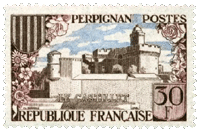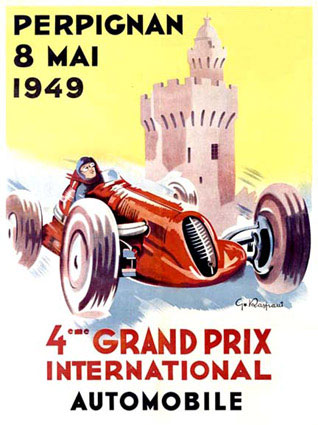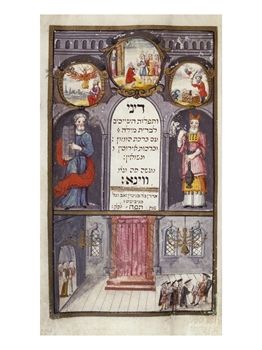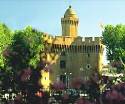
![]()
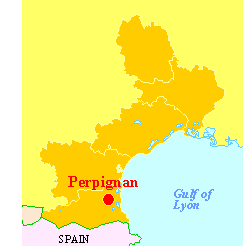
![]() Perpignan
is the capital of the département of Pyrénées-Orientales.
It is located on the Têt River, 8 miles west of the Mediterranean
Sea and 19 miles north of the modern Spanish border
within sight of the Pyrenees
(
Perpignan
is the capital of the département of Pyrénées-Orientales.
It is located on the Têt River, 8 miles west of the Mediterranean
Sea and 19 miles north of the modern Spanish border
within sight of the Pyrenees
( Pirenèus,
Pirenèus,
 Pirineus,
Pirineus,
 Pyrénées).
Catalonia straddles the border, so Catalan culture is dominant
in the language and cuisine.
Pyrénées).
Catalonia straddles the border, so Catalan culture is dominant
in the language and cuisine.
Perpignan was the capital of the old Catalan province of Roussillon, under the Counts of Roussillon. In 1172 it became the possession of Jaime (James) I, King of Aragon. When he died, his realm was divided between his sons. His younger son, also called Jaime, got a rather bizarre ersatz kingdom, called the Kingdom of Majorca which included the Roussillon, Majorca and other Mediterranean possessions. Jaime was the first of three hereditary kings of Majorca. They made the city their capital between 1276 and 1344. Perpignan was a stronghold town throughout the middle ages.

![]() In
1659 Perpignan became French as the result of the Treaty
of the Pyrenees. Like other fortification on near the
new border perpignan was visited by the french military
genius de Vauban with a view to consolidating the new border.
When Vauban made his first trip to the region in 1669 Perpignan
was defended by an immense system of ramparts boasting nine
bastions. In addition there was an impressive citadel complex
with six more. The system of defence works was so good that
(unusually) Vauban's role was limited to repairs and refinements.
His main improvements were in adding outworks. The outline
shown on the right is classic Vauban - and therefore classic
17th century fortification work. Sadly, perpignan's city
walls were dismantled towards the end of the 19th century.
Today little or nothing remains of the town's defences except
for the citadel.
In
1659 Perpignan became French as the result of the Treaty
of the Pyrenees. Like other fortification on near the
new border perpignan was visited by the french military
genius de Vauban with a view to consolidating the new border.
When Vauban made his first trip to the region in 1669 Perpignan
was defended by an immense system of ramparts boasting nine
bastions. In addition there was an impressive citadel complex
with six more. The system of defence works was so good that
(unusually) Vauban's role was limited to repairs and refinements.
His main improvements were in adding outworks. The outline
shown on the right is classic Vauban - and therefore classic
17th century fortification work. Sadly, perpignan's city
walls were dismantled towards the end of the 19th century.
Today little or nothing remains of the town's defences except
for the citadel.

![]() The
modern town has crept right up to the citadel's walls (encroaching
housing is faded in the ariel photograph above to make the
citadel's outline more obvious). At the heart of the citadel
is the fortress palace of the former Kings Of Majorca, surrounded
by a later bastioned citadel built by the engineers of the
Emperor Charles V. The greater part of the compex remains
in tact today is attributable to the fact that it houses
not just an historically important palace but also an operational
army barracks.
The
modern town has crept right up to the citadel's walls (encroaching
housing is faded in the ariel photograph above to make the
citadel's outline more obvious). At the heart of the citadel
is the fortress palace of the former Kings Of Majorca, surrounded
by a later bastioned citadel built by the engineers of the
Emperor Charles V. The greater part of the compex remains
in tact today is attributable to the fact that it houses
not just an historically important palace but also an operational
army barracks.
An outer layer of the citadel today still houses a large barracks which backs on to the old Royal Palace. The two are separated by the moat which surrounds the old palace and which divides the centre of the citadel complex in two. the whole area is surrounded by a third system of defences, a massive six bastioned curtain wall constructed by the Spaniards in the reign of Phillipe II.
In summary the four rings of defences, working from the centre are:
- The fortified palace, with moat, circa 1300
- The Bastioned citadel built for Emperor Charles V, c. 1540
- The citadel built for Phillip II of Spain, c. 1590
- Vauban's outworks - c. 1700.
During and after the Spanish Civil War (1936-39) the city received Spanish Republican refugees. After Algerian independence was conceded in 1960, it became a refuge again, this time for French settlers from North Africa. In 1971, the University of Perpignan was established.
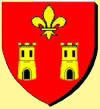
![]()

 The
city has long been a flourishing market centre for the wines,
fruit, and vegetables. Most of the produce comes from the
rich plain on which the city is located. These plains are
alluvial, with plenty of sunshine and water from the Pyrenees.
They are also the furthest south in all of France, so historically
the area around Perpignan provided the rest of France with
the earliest fruit and vegetables each year. The premium
prices disappeared along with demand, as refrigeration become
common.
The
city has long been a flourishing market centre for the wines,
fruit, and vegetables. Most of the produce comes from the
rich plain on which the city is located. These plains are
alluvial, with plenty of sunshine and water from the Pyrenees.
They are also the furthest south in all of France, so historically
the area around Perpignan provided the rest of France with
the earliest fruit and vegetables each year. The premium
prices disappeared along with demand, as refrigeration become
common.
|
If you wonder why there is a statue of Salvador Dali outside the railway station, it is a tribute to the man who helped the tourist trade by claiming, after a visionary experience, that Perpignan Railway Station was the centre of the universe. Other things to see include: |
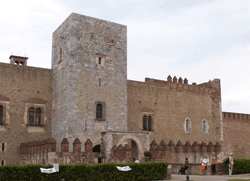
 The
Palais des Rois de Majorque. The medieval palace of
the kings of Majorca dating from the 13th and 14th centuries.
It is partially restored and may be found in the southern
part of the town. It is surrounded by the bastions of a
great 17th and 18th century citadel.
The
Palais des Rois de Majorque. The medieval palace of
the kings of Majorca dating from the 13th and 14th centuries.
It is partially restored and may be found in the southern
part of the town. It is surrounded by the bastions of a
great 17th and 18th century citadel.
The Rigaud Museum contains a collection of paintings by Catalan primitive artists and by the Perpignan native, Hyacinthe Rigaud. You will find it in the Castillet, a 14th and 15th century crenellated fort that once defended the principal gate in the city walls. (Rigaud settled in the Castillet)

